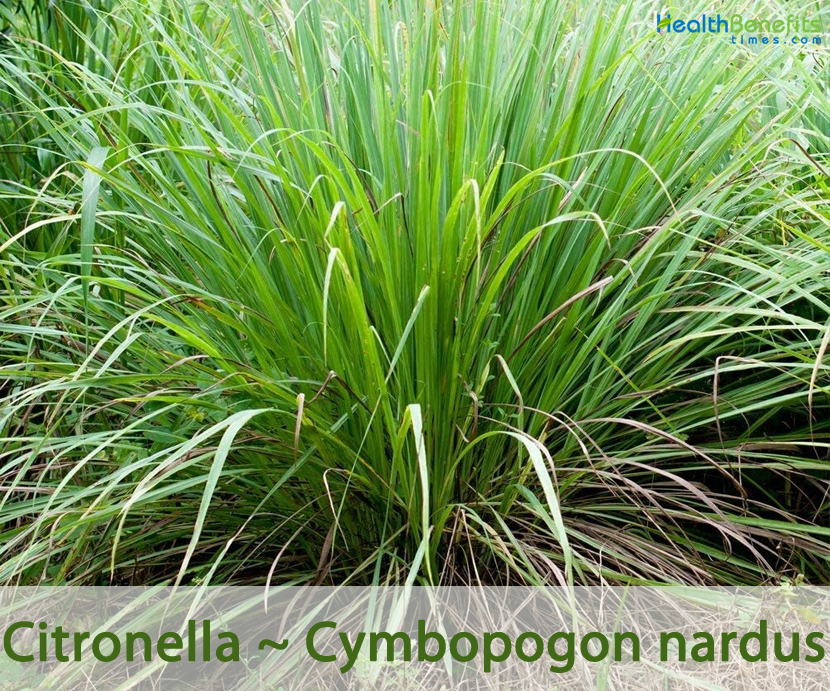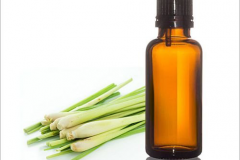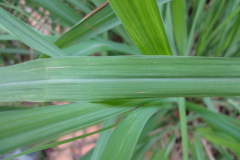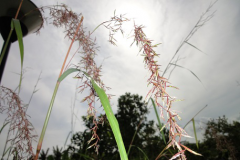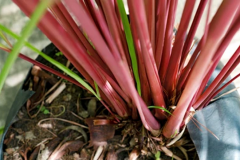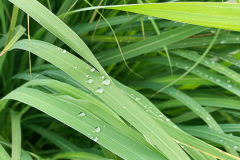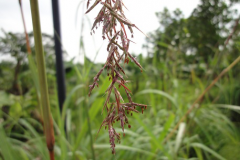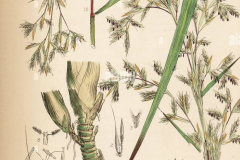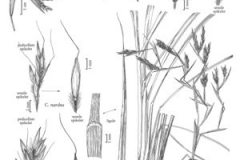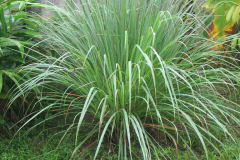Citronella Facts
| Citronella Quick Facts | |
|---|---|
| Name: | Citronella |
| Scientific Name: | Cymbopogon nardus |
| Origin | Southeast Asia and grown commercially in Sri Lanka, India, Burma, Indonesia and Java |
| Health benefits | Support for intestinal worms, stomach pain, rheumatism, digestive problems, fever and intestinal problems, treat colds, flu and headaches, leprosy and epilepsy |
| Name | Citronella |
|---|---|
| Scientific Name | Cymbopogon nardus |
| Native | Native to southeast Asia and grown commercially in Sri Lanka, India, Burma, Indonesia and Java. It is widely naturalized in tropical Asia and grown as an ornamental in South Florida and southern California. Its native status in Africa is disputed. |
| Common Names | Ceylon citronella, citronella, citronella grass, giant turpentine grass, nard grass, new citronella grass, reuse terpentyngras, citronelle, ceyloncitronell, citronellgras, citronela de Java, zacate limón, nardus, Geranium grass, Mana grass, Nardus grass, Tambookie grass, lemon grass |
| Name in Other Languages | Afrikaans: Sitronella, Reuseterpentyngras, Tamboekiegras Albanian: Citronella Amharic: Citronella-ˌsitrəˈnelə (ሲትሮኔላ) Arabic: Alsitrunila (السترونيلا) Armenian: Kitronela (կիտրոնելա), citronella Azerbaijani: Sitronella, citronella Basque: Citronella Belarusian: Citraniella (цітранелла) Bengali: Nibāraṇakārī sā iṭrōnēlā (নিবারণকারী সাইট্রোনেলা) Bosnian: Citronele Brazil: Ceilao lenabatu, citronela do Bulgarian: Citronella (цитронела), цитронела Burmese: Citronella (sitrəˈnelə), (hsap-pra sa.pa:ling), Kaingbyu-mi, Myet-hmwe, Sa.pa:ling, Sa.pa:ling hsi-mhwé:, Sabalin-hmwe, Singu-myet, hcaparr lain se mwhaayy (စပါးလင်ဆီမွှေး) Catalan: Citronella Cebuano: Sama sa citronella Chichewa: Citronella Chinese: Xiāng máo (香茅), Ya xiang mao (亚 香茅), Xiang mao (香茅), Yà xiāng máo (亞香茅) Congo Democratic Republic: False citronella Corsican: Citronella Croatian: Citronele Czech: Citronella Danish: Citronella, Lenabatugræs Dutch: Citronella, Citroenmelisse English: Citronella, Ceylon citronella, Citronella grass, Geranium grass, Mana grass, Nard grass, Nardus grass, Tambookie grass, Giant turpentine grass, New citronella grass, lemon grass Esperanto: Citronelo, cimbopogono Estonian: Tsitronella, citronella Filipino: Citronella Finnish: Citronella, Jäkkisitrusheinä French: Citronelle, citronnelle de Ceylan, citronnelle de Sri Lanka Frisian: Citronella Galician: Citronela Georgian: Tsit’ronela (ციტრონელა), citronella German: Citronella, Ceyloncitronell, Citronellgras, Nardusgras, dichtblattriges Zitronellagras Greek: Aromatódis chlói (αρωματώδης χλόη), aromatódis chlói (αρωματώδης χλόη), Kitronella (Κιτρονέλλα), Lemonochorto (Λεμονόχορτο) Gujarati: Siṭrōnēlā (સિટ્રોનેલા), citronella Haitian Creole: Sitwonèl Hausa: Citronella Hawaiian: Akala Hebrew: Citronella, ציטרונלה Hindi: Sitronela (सिट्रोनेला), naid grass Hmong: Citronella Hungarian: Citromfüvet, citronella Icelandic: Sítrónu, Citronella Igbo: Citronella Indonesian: Serai, serai wangi Irish: Citronella Italian: Citronella, Citronella di Ceylon Japanese: Shitoronera (シトロネラ), Kou suigaya (コ ウスイガヤ ), Seiron shitironera (セ イロンシトロネラ), Shitoronera (シトロネラ), Shitoronera gurasu (シトロネラグラ ス) Javanese: Citronella, Seré Kannada: Siṭronellā (ಸಿಟ್ರೊನೆಲ್ಲಾ), Kamāci hullu (ಕಮಾಚಿ ಹುಲ್ಲು) Kazakh: Citronella (цитронелла), tsitronellı (цитронеллы) Kenya: Blue citronella grass Khmer: Citronella Kinyarwanda: Citronella Korean: Siteulo nella (시트로 넬라) Kurdish: Citronella Kyrgyz: Citronella Lao: Sitrəˈnelə (citronella), hua sikhai (ຫົວສີໄຄ) Latin: Citronella Latvian: Citronella Lithuanian: Citronella, kvapiųjų citrinžolių Luxembourgish: Citronella Macedonian: Citronela (цитронела), citronella Malagasy: Citronella Malay: Citronella, Serai wangi Malayalam: Siṭrēānella (സിട്രോനെല്ല), sarvādhipanāṁ (സര്വാധിപനാം) Maltese: Citronella Mali: Tiberimt, tiekala-ba Maori: Citronella Marathi: Sitronela (सिट्रोनेला), citronella Mongolian: Citronella (цитронелла) Myanmar (Burmese): Citronella Nepali: Sitronela (सिट्रोनेला), citronella Netherlands: Citroenmelisse Nigeria: Tsaure Niuean: Kamapui Norwegian: Citronella Oriya: ସାଇଟ୍ରୋନେଲା | Pashto: Citronella Persian: سیترونلا Polish: Citronella, Cytronella, Palczatka szczetna Portuguese: Citronella, Citronela de Ceilan, Citronela do Ceilão, Lenabatu, citronela-de-java, Capim-de-cheiro, Capim-santo Punjabi: Siṭarōnēlā (ਸਿਟਰੋਨੇਲਾ) Romanian: Lămâiță Russian: Tsitronelly (цитронеллы), Кафа (ајурведској медицини), Citronella (Цитронелла), Pomerantsevaya trava (Померанцевая трава) Samoan: Citronella Scots Gaelic: Citronella Senegal: Beignefala Serbian: Citronella (цитронела) Sesotho: Citronella Shona: Citronella Sindhi: سائيٽرونلا Sinhala: Pæn̆giri (පැඟිරි) Somali: Citronella Southern Africa: Reuse terpentyngras Slovak: Citronella Slovenian: Citronela Spanish: Citronella, Zacate limón Sri–Lanka: Lenabatu citronella Sundanese: Citronella, sitronella Swahili: Citronella Swedish: Citronella, Citronellagräs Taiwan: Citronella grass Tajik: Citronella-ˌsitrəˈnelə Tamil: Ciṭrōṉellā (சிட்ரோனெல்லா) Tatar: цитронелла Telugu: Krimisanhārika tailamu (క్రిమిసంహారిక తైలము) Thai: Takhịr̂h̄xm (ตะไคร้หอม), dtôn-jà-krái-má-kòot (ต้นจะไคร้มะขูด ), Ta khrai hom (ตะไคร้ หอม) Turkish: Esans çıkarılan bir Güney Asya out Turkmen: Sitronella Ukrainian: Citronela (цитронела), tsytronelly (цитронелли) Urdu: Citronella Uyghur: Citronella Uzbek: Sitronella, citronella Vietnamese: Cây sả, Cu Sa Welsh: Citronella, sitronela Xhosa: Citronella Yiddish: Sitronella (סיטראָנעללאַ) Yoruba: Citronella Zulu: Icronella, citronella, isiQunga |
| Plant Growth Habit | Tall tufted, aromatic, evergreen, clump-forming, long-lived perennial grass |
| Growing Climates | Grassland and open woodland, moist, lowland tropics |
| Soil | Tolerant of a wide range of well-drained soils, moderately rich, moist soil will produce the best growth |
| Plant Size | 6ft tall (1.8m) and 4ft wide (1.2m) in the right conditions |
| Culm | Culms tufted, robust, up to 2.5 m tall, 1-2 cm in diameter |
| Leaf | They also have narrow, tall lance-shaped, blade-looking foliage. It can grow up to 60-70 centimeters long. |
| Flower | Flower cluster is narrow, 15-30 cm long with racemes (unbranched inflorescence) 8-10 mm long, often rather covered with long soft hairs; spikelets without stalks, flat or concave on the back with winged keels (resembling the keel of a boat), awn (bristle-like structure) 5-6 cm long. |
| Flavor | Lemony scent |
| Propagation | By Seed |
| Plant Parts Used | Whole part of plant, leaves |
| Precautions |
|
Plant Description
Citronella is a tall tufted, aromatic, evergreen, clump-forming, long-lived perennial grass that normally grows about 6 ft. (1.8m) tall and 4 ft. (1.2m) wide in the right conditions. The plant is occasionally cultivated in tropical areas for its essential oil, which is used as food flavoring. In cooler climates, citronella plants are grown as annuals and brought indoors over winter. It’s closely related to lemon grass. The plant is found growing in grassland, open woodland, moist and lowland tropics. It is tolerant of a wide range of well-drained soils, moderately rich, moist soil will produce the best growth. Culms are tufted, robust, up to 1.5 m tall, 1-2 cm in diameter.
Leaves
Citronella’s mid-green leaf blades grow from a crown and can be up to 1m long. They are narrow, tall lance-shaped and blade-looking. The base of the leaf, known as a pseudo-stem, is a reddish color. Like all grasses, it does produce flower stems and seed heads, but they are not the main attraction.
Citronella looks like, and is closely related to, lemongrass, but they are not interchangeable! Lemongrass does not have any red at the base of its stems—they are green.
Flower
Panicle (flower cluster) is narrow, 15-30 cm long with racemes (unbranched inflorescence) 8-10 mm long, often rather covered with long soft hairs; spikelets without stalks, flat or concave on the back with winged keels (resembling the keel of a boat), awn (bristle-like structure) 5-6 cm long.
Different uses of Citronella
1. Insect Repellent
With a strong reputation for repelling biting insects, Citronella essential oil consists of volatile oils that irritate mosquitoes in particular. Whilst there is much controversy about the effectiveness of Citronella and its protection from bites, there is certainly research to back it up. In 2011, an analysis of 11 studies on the capabilities of Citronella oil, researchers found that when combined with vanillin, the oil did certainly provide protection for up to three hours. Additionally, research was published in “The Israel Medical Association Journal” which showed how Citronella can be effective in helping to prevent head lice too.
If you are using this oil as an insect repellent, it is vital that it is diluted at around a 2% dilution to avoid skin irritation. If Citronella is being used alone to repel insects, research indicates that it needs to be reapplied every 30 minutes to 1 hour to remain bite free. Some researchers recommend mixing Citronella with other bug battling essential oils such as lemon eucalyptus, neem and lemongrass.
2. Antibacterial/Antiseptic
Citronella oil is rich in the compound methyl isoeugenol which imparts powerful antibacterial and antiseptic qualities to this essential oil. With an invigorating, fresh lemony scent, Citronella is also an excellent addition to natural house cleaning products. It will disinfect kitchen surfaces, bathrooms, floors, and all whilst leaving a lovely chemical free aroma in the room – this makes it a perfect air freshener too, whilst keeping the home free of airborne pathogens.
3. Anxiety/Stress
Citronella has a naturally uplifting and happy smell, with research showing that it can be both uplifting and relaxing. It appears to work on both the sympathetic and parasympathetic nervous system, providing natural stress relief. The essential oil can also be used (well diluted), for dogs – not only to keep fleas and ticks at bay, it can help to reduce separation anxiety and constant barking.
4. Anti-inflammatory/Pain Relief
Whilst inflammation is a valid healing response by the body, persistent low level inflammation can lead to a whole host of problems and worsen existing ones such as osteoarthritis and rheumatoid arthritis. Citronellal is the chief compound found in Citronella oil, with research studies showing it exhibits a strong anti-inflammatory effect. It also contains potent antioxidant compounds that aid in the removal of free radicals, one of the major causes of persistent inflammation.
It can be extremely soothing when diluted with carrier oil and massaged into sore tired muscles, swollen joints and into the abdomen for menstrual cramps. Taken internally it can help to inhibit inflammation in the digestive tract, stomach and liver.
5. Skin Health
This versatile oil can work wonders for the skin. It can help to heal dermatitis and eczema, slow down skin aging and treat fungal infections such as athlete’s foot. As part of a beauty routine, its antibacterial and astringent qualities make Citronella essential oil great for use on oily skin and as a remedy for acne.
6. Hair Health
The high limonene and methyl isoeugenol content in Citronella oil makes it effective in regulating and decreasing the amount of sebum oil produced by the scalp, combating greasy hair. It also soothes and nourishes a dry or itchy scalp, eliminates dandruff and can prevent head lice.
Traditional uses and benefits of Citronella
- Practitioners claim citronella oil is a stimulant when inhaled or rubbed on the skin, and an antiseptic that can be used to sterilize food preparation surfaces.
- It is also used in Chinese medicine and traditional medicine for the treatment of rheumatism, digestive problems, fever and intestinal problems, and in aromatherapy to treat colds, flu and headaches.
- It is used to treat lice and other parasites, like intestinal worms.
- It is anti-bacterial, anti-microbial, anti-inflammatory and anti-fungal.
- Bitter and sweet in taste, the plant can cause loose bowels, and feelings of hunger.
- It can be used to control flatulence and to treat leprosy, epilepsy, and diseases associated with the intestines.
- Whole plant is used as an antispasmodic, carminative, and diaphoretic.
- Oil is used topically to relieve joint inflammation; on the scalp to stop hair loss; and on the skin to treat scabies, rashes and other conditions.
- Liquid from soaking the leaves in hot water can be taken for shooting stomach pains.
- Juice from crushed leaves is applied to treat arm or leg paralysis.
- Citronella reduced blood pressure, respiratory rate, and heart rate following inhalation.
- Individuals who had taken citronella had reported better mood and were fresher.
- Citronella has an anti-amoebic effect and is effective against Entamoeba histolytica.
- Citronella also acts as an anti-bacterial and is active against various bacterial organisms like Bacillus subtilis, Escherichia coli, Staphylococcus aureus, and Salmonella species.
- Citronella is also effective against body and head lice.
- Citronella oil can be combined with neem and coconut oil for the prevention of head lice transmission.
- Citronella is used as a fever reducer, insect repellent, anti-parasitic and as a soothing agent for pain, inflammation and skin healing.
- In many cultures it has been traditionally used to reduce fevers, as an insect repellent, for digestive issues and to expel intestinal parasites.
- It is also used to treat lice and other parasites (including intestinal worms!).
Culinary Uses
- It is used in teas and desserts.
- Dry the leaves for use as a potpourri.
- The leaves are a delicious seasoning for tea, curries and soup.
- The white center of the succulent stems is used to impart a flavor to curries.
- An aromatic tea can be obtained from the leaves.
- An essential oil is obtained from the plant.
- It is much used by the food industry to flavor a wide range of foods.
- Citral can be used to imitate apple, lemon, strawberry and vanilla flavors.
Other Facts
- Citronella is the source of citronella oil, used in perfumery and as an insect repellent.
- Inexpensive soaps sold in Asian markets are scented with citronella oil.
- Citronella oil can be mixed with other vegetable oils and used in massage or rubbed on the skin for an insect repellent.
- Citronella candles and incense, however, are less effective.
- Citronella emits a pleasant fragrance and is planted along walkways or near houses.
- It is also reported that citronella oil repels cats.
- Essential oils are extracted from the aerial parts and applied topically or slowly burned as an insect repellent, particularly to deter haematophagous insects such as mosquitoes.
- Citronella is also used as a fumigant against adult houseflies and red flour beetles.
- It has a long history of use as an ingredient in perfumes, soaps and natural deodorizers.
- It has also been widely used in Southeast Asian countries as a flavoring for foods and beverages.
- It can also be used for thatching, mulching and erosion control.
Prevention and Control
Due to the variable regulations around (de)registration of pesticides, your national list of registered pesticides or relevant authority should be consulted to determine which products are legally allowed for use in your country when considering chemical control. Pesticides should always be used in a lawful manner, consistent with the product’s label.
Control
Whichever control method is chosen, controlling the weed before it seeds will reduce future problems. Control is generally best applied to the least infested areas before dense infestations are tackled. Consistent follow-up work is required for sustainable management.
Cultural Control and Sanitary Measures
The manipulation of grazing regimes can be used as a management method. Light grazing encourages growth, but heavy grazing pressure of one bullock per hectare prevented re-colonization of C. nardus; however, it is generally avoided by grazers. Periodic heavy stocking was able to convert a slope pasture of 47% C. nardus to a mixed pasture dominated by Brachiaria decumbens. The application of 158 kg N/ha increased the content of B. decumbens still further.
Physical/Mechanical Control
Uprooting the tufts with a hoe is effective over small areas but was deemed impractical on large scale areas due to high labor costs. At 2005 prices, this mode of control was costed at 1 Ankole cow per acre of land cleared (approx. US $175). Burning the grass is also suggested, but C. nardus regrows immediately when the rains come.
Chemical Control
Spot spraying with glyphosphate can reduce C. nardus without negatively impacting indigenous species.
References:
https://www.itis.gov/servlet/SingleRpt/SingleRpt?search_topic=TSN&search_value=41615#null
http://www.hear.org/pier/species/cymbopogon_nardus.htm
https://www.cabi.org/isc/datasheet/120396
https://gd.eppo.int/taxon/CYGNA
http://www.theplantlist.org/tpl1.1/record/kew-406227
https://en.wikipedia.org/wiki/Cymbopogon_nardus
https://genbank.africarice.org/gringlobal/taxonomydetail.aspx?id=12810
https://www.feedipedia.org/node/601
https://plants.usda.gov/home/plantProfile?symbol=CYNA


